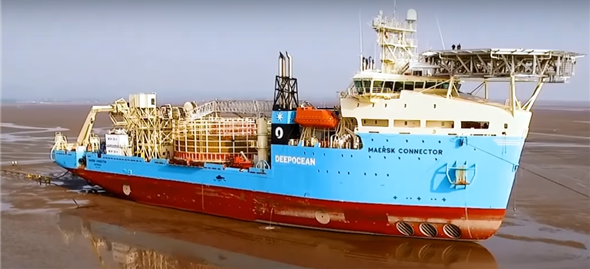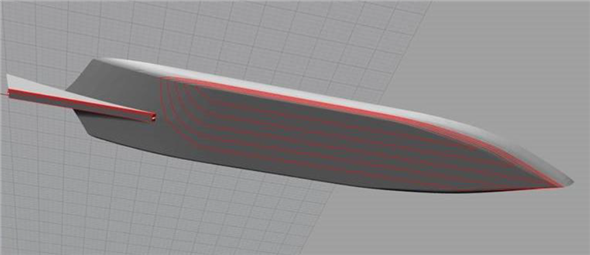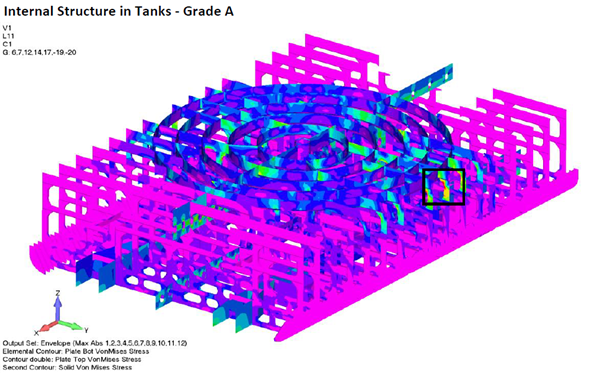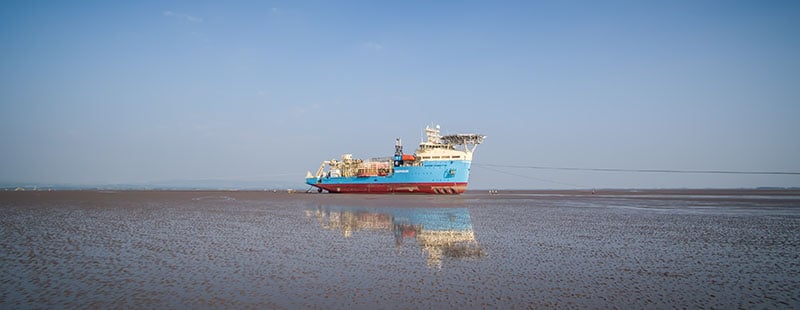MV Maersk Connector, which is insured by Skuld Offshore, is Maersk's first cable-lay vessel specifically designed to be intentionally grounded as part of a cable-lay operation.
In this article, along with assistance from Maersk Supply Service, Longitude Engineering and London Offshore Consultants, Katinka Mørch Granberg looks at this ground-breaking operation and how it is dealt with from an underwriting perspective.
The rise in renewable energy projects has led to a correlative increase in subsea power cable installation. Offshore wind farms all require export cables to bring their power to the electricity grid but there are complex and wide-ranging engineering challenges attendant to laying these cables. In addition, the cables are expensive, heavy, stiff and highly susceptible to damage during installation, especially during the complex 'pull-in' operations when the cable transitions from subsea to onshore.
Traditionally, the standard method of installing such a cable was to join two cables (one from the shore side and one from offshore) together somewhere in the transition area. This is a relatively complex operation, and results in higher costs and potentially less reliability. As such, a cable laid in a single piece would be more reliable and less expensive. However, to do so requires a very specific type of unit which can operate both in deep water and on the inshore. This problem led to the design of MV Maersk Connector.
Design of the vessel
The Maersk Connector is a new generation of cable-laying vessel, developed as a flexible platform for both transport and installation work offshore. The 138m long and 27m wide vessel delivers more efficient, cost-effective cable installation, with the capability of grounding out on the seabed with its seven points mooring system. This eliminates the need to also charter a separate shallow water cable-lay vessel and minimises the number of cable joints required. Maersk Connector has state-of-the-art equipment, including a 7,000 tonne capacity cable carousel and a 100 tonne subsea crane, to help clients achieve their goals in a professional and cost-effective manner. The vessel can also accommodate 90 people.
Preparation for grounding
Even though the vessel is specifically designed to ground, there are still a significant number of procedures which must be followed and approvals that have to be obtained before the go-ahead can be given. In relation to this, it is particularly important that the "grounding corridor" is surveyed by an engineering consultancy firm in order that it is clear what potential obstructions are on the seabed and also whether there are any ripples making the seabed uneven. As the vessel has to ground without damaging the hull and without the azimuth thruster pods, these surveys are extremely important.
For the Walney Wind Farm engineered grounding project, which was the debut project for this type of operation, there were a number of anti-glider poles (WWII beach defences) within the grounding corridor on the beach which had to be cleared, along with other potential obstructions such as large boulders.
In addition, a wider area was also surveyed for unexploded ordnances (UXOs), whereafter certificates were issued confirming that the risk had been reduced to a level as low as reasonably practicable.
In the lead-up to the operation, substantial preparation was ongoing both aboard the vessel and in the project office. Before attempting the grounding, it was essential to ensure that the conditions were within acceptable parameters, and compliant with the recommendations of the marine warranty surveyor.
The actual grounding
The concept of the project is that the vessel travels as close to shore as possible, known as the grounding location, with her stern facing shore. Once at that location, the vessel will be anchored in situ before coming to rest on the seabed on a falling tide. The reason why the vessel is positioned 'stern to' is that the cable is spooled off the reel over the stern, the most straightforward way to run out the cable. The pull-in operation can take multiple days (the Walney project pull-in took two days) during which time the vessel will be afloat and grounded with the change in tide every 12 hours.
To ensure the success of the operation, it is essential that the vessel is in the correct location at exactly the right time. As part of this, a route plan is loaded into a plotter on the bridge. The plotter screen shows time marks every 25 m with a 'not before – not later' time, setting out exactly where the vessel has to be and which has to be carefully followed. For the Walney project, the surplus depth of water was only 13 cm more than the minimum under keel clearance, so full confidence had to be put on the sea bed profile survey and the draft and stability calculations.
With the tide falling and when keel clearance has dropped to 0.5 m, a ballast sequence is started on the vessel, taking in up to 5,000 m3 of seawater to quickly set the vessel on the seabed and ensure sufficient cooling water is available for the main engines. From the point at which the vessel arrives at the grounding location there is less than an hour to run and tension the 4-6 anchors which are deployed to hold the vessel in position (and can be used to crab the vessel back up the run-in toward deeper water). Each anchor is deployed at a distance of between 400-900 m from the vessel.
For maximum efficiency, the specialised multicat vessels (which can also ground) are used to run the anchors are connected up at the run-in position in anticipation of the vessel arriving. When the anchor spread is established, the vessel is taken out of dynamic positioning (DP) mode and a 'Quick Ballast' procedure is initiated in order to ground smoothly.
Together with the ebb tide, the ballast intake will bring the vessel down the remaining depth in just 30 minutes. While doing that, roughly 5,000 m3 of seawater is ballasted. This is sufficient for both bringing the vessel down and providing sufficient water for 8 hours of internal engine cooling and cannot be completed after the tide has fallen. As the vessel is resting on the dry seabed, it is important that there is full support along the length of the hull, but also that there is sufficient clearance underneath the azipods so that they are not damaged through contract with the seabed. In the Walney project, as an additional precaution, trenches were excavated under the azipods to ensure clearance. This was also an insurance requirement.
As noted above, while grounded and rising with the tide, the vessel is laying in anchors. The anchor spreads are specifically engineered for every single grounding and procedures are set up for all sequences during the "skids", which is the term used for each move between grounding locations. The skids are also subject to specific procedures and there are agreed operational limitations in place in relation to wind, sea current and vessel dynamics to ensure crew safety and protect the integrity of the vessel.
Once the vessel is well grounded and there is a dry seabed around the vessel, special vehicles bring out a wire which gets connected to the cable and the pull-in process starts. In the Walney project, two shore end cables were pulled roughly 3 km over the mud flats supported by hundreds of rollers.
When the cable is stable and ashore, the process of "crabbing" towards deeper water starts as soon as the tide lifts the vessel off the seabed. The transit over the mud-flats cannot commence until the vessel has sufficient keel clearance. The anchor spread is used in combination with the DP system to stabilise the vessel against the current and to move ahead while laying the cable and towing a 50 tonne plough, which simultaneously buries 3 m into the seabed.
In the Walney project, after 6 groundings the vessel was sufficiently far from shore to be afloat even during low-water. Cable lay operations thereafter continued as normal for offshore operations, with support provided by an additional, "pull-ahead" tug (in the Walney project, Maersk Trader was used) to give a lay speed of 600-1,000m per hour.
The idea of intentionally taking a vessel to ground away from a dry dock or sheltered, alongside mud berth would be considered imprudent to most masters, yet with certain marine operations the risks of such a grounding can be acceptable.
Landing locations for cables are typically gently shoaling beaches which are suitable for safely burying the cable once laid. However, very large cable lay vessels typically require around 6 metres of water to float, which can leave a large distance between the point at which the vessel can remain afloat at all states of the tide and the point to where the cable must be pulled.
DeepOcean's Maersk Connector high and dry during the installation of the WOW3 export cable for the Walney Extension Wind farm. Note anchor lines used to hold position during grounding and re-floating and the power cable passing over the stern
To reduce this distance, one solution is to float the vessel in on the highest spring tide and then let her go to ground for the rest of the tidal window, in some cases leaving the vessel high and dry for several hours. This avoids transpooling cable to a separate barge to increase access, or other expensive and risky operations such as jointing a separate length of cable.
However, taking a vessel aground is not straightforward. To mitigate the risks of damaging the vessel, a detailed geotechnical and geophysical survey must be conducted to understand the composition and shape of the seabed many meters below the mudline. This data is then post-processed and combined with detailed information of the vessel's geometry to determine how the vessel will penetrate the upper seabed layers.

A plot showing the contact geometry between the vessel and the seabed in the Walney project, which was used to calculate the pressures and forces acting on the vessel as she grounded out
Longitude Engineering has developed numerical models to combine dynamic vessel behaviour with this seabed response to quantify the likely pressures and forces applied to the hull and ensure they remained within acceptable levels. It is also important to assess the longitudinal strength of the vessel, based on the variable support of the seabed along the vessel's full length. This considers the loads within the vessel (power cable, fuel, water etc.) so that grounding locations can be accurately selected to avoid undue stress on the vessel.
A hydrodynamic mesh of the vessel. The panels seen are used to solve how water pressure acts on the hull and in turn calculate the motion response due to an applied wave
The outcome of this analysis are parameters and a clear weather limit for grounding operations that could be put in place by a Marine Warranty Surveyor. This will be based on an analysis which achieves a practical level of operability allowing the operation to be carried out during the essential tidal window.
Once the vessel is aground, the cable can be pulled to the shore over a series of rollers by excavators. The vessel can then be re-floated, and use her anchoring system to carefully 'skid' to the next grounding location before the tide recedes, leaving it aground once again. This process is then repeated until the vessel is back in deep water, at which stage it can switch to holding station using the dynamic positioning system, and continue with cable laying operations.

A plot showing the Global Finite Element Analysis of a cable ship, used to consider the strength of the vessel during operations when carrying heavy cable loads
Operations such as this can reduce the near-shore pull-in considerably. With it having been recently successfully tested with a custom-built offshore cable lay vessel, the analysis and approach that was used looks set to pave the way for similar operations to be performed in the future and give developers and installation contractors more options for performing complex shore cable pull-ins.
Skuld Offshore was established to specifically meet the needs of vessel owners partaking in specialised offshore activities. The way in which P&I cover is arranged provides many benefits to owners. However, those arrangements also mean that certain risks assumed under progressive offshore operations fall outside the scope of mutual cover. In those circumstances, Skuld Offshore can offer a number of additional commercial covers for certain excluded risks which may be reinstated by purchasing an extension to the standard poolable cover.
The starting point for deciding whether such covers are required is an assessment by the underwriter of the scope of work and the contractual matrix. This can either be carried out prior to cover incepting (for example if the vessel to be insured is a dredger, which always will be performing operations outside the scope of mutual P&I cover) or on a job-to-job basis where the vessel may be performing one-off operations which stray beyond the scope of standard mutual cover.
For an operation like this, there are two separate aspects that must be considered:
- a typical offshore cable-laying operation; and
- the novel engineered grounding element
There are certain cable-laying risks that are outside the scope of poolable cover, but these are familiar risks which our experienced offshore underwriters are well used to dealing with. The risks attendant to the engineered grounding are, however, much more unusual and require specific consideration.
As a starting point for that, the Assured should provide underwriters with a complete overview of the intended operations and the relevant contractual documentation at as early a stage of the project as possible. This will allow the club's underwriters and internal technical experts to liaise in relation to the technical risk and for our specialist contract lawyers to set out the contractual risk.
For an operation of this nature, important information for the P&I underwriters will typically include:
- Scope of work
- Bathymetry study of the operational area
- Marine warranty surveyor assessment of the operations
- Details as to the vessel's capacity
- Surveyor report
- Contractual documentation
Once the review has been completed, the underwriter can assess the risks in the context of the current cover arrangement. As most risks arising out of the operation are outside the scope of poolable cover, it will be necessary to put in place a bespoke suite of additional covers to respond to those risks that cannot be picked up under the mutual covers.
Understanding the risk
In assessing the risk, it is important to consider what the operation entails and how this will interact with the traditional mutual P&I cover and an engineered grounding creates a unique set of additional factors which need to be incorporated into the underwriting. For example, when the vessel is aground, it is potentially exposed to contact from land based vehicles involved in the operation – how will those liabilities be dealt with? What if unexpected weather or tidal conditions cause the vessel to ground in a manner different to that forecast, resulting in damage to the hull and a wreck removal and or pollution event? When the vessel is aground, can traditional marine risks such as crew injury still be covered under the mutual element of the cover? These questions and more are those weighed when understanding and assessing the risk.
The P&I insurers would typically be concerned about the liability arising out of this operation, such as collision or contact with other vessels involved in the operation, pollution liabilities and personal injury matters.
The Assured should make sure they have an indemnity from the parties working on shore with the land based equipment, such as the trucks involved etc. If no indemnity can be reached, then the Assured need to inform their P&I insurers to consider the possibility of finding an underwriting solution to this risk.
Damage to fixed and floating objects and collision liability is another risk as the vessel will be towed and pulled in directions by tugs. The Assured should make sure they have an indemnity with the owners and operators of the tugs. The contract between the Assured and the appointed tugs should be sent to the Skuld Offshore contracts team for review if this contract is not based on knock for knock. If the contract is not at knock for knock, Skuld can cover certain liabilities that arise out of the contract under the extended contractual liability cover.
For any further questions related to intentional grounding and P&I insurance cover, please contact your responsible Skuld Offshore underwriters.
